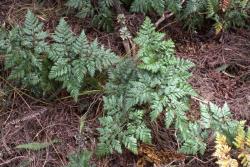Epiphytic, rupestral or terrestrial ferns. Rhizomes long-creeping, scaly. Rhizome scales subulate or narrowly ovate, peltate, concolorous (not NZ) or with pale margins and dark centres (NZ), margins entire (not NZ) or toothed (NZ), with or without multiseptate hairs on the margins. Fronds monomorphic or dimorphic, articulated to phyllopodia. Laminae 3-pinnate to 4-pinnate-pinnatifid (NZ) or also pinnatifid to 2-pinnate-pinnatifid (not NZ), coriaceous, glabrous or with scattered scales. Veins free; false veins sometimes present between true veins. Sori oblong or obovate. Indusia attached at base and at least part of the sides, pouched (NZ) to lunate (not NZ). Spores monolete; perispores verrucate, tuberculate or rugose.
A genus of c. 65 species (Tsutsumi et al. 2016; PPG 1 2016).
Davallia was revised by Nooteboom (1994, 1998), who recognised 34 species, with 30 species in section Davallia and four in section Scyphularia. He included species formerly belonging to Araiostegia, Humata and Pachypleuria but retained Davallodes, Leucostegia and Gymnogrammitis. Leucostegia is now treated in Hypodematiaceae and Gymnogrammitis in Polypodiaceae (PPG 1 2016), but Davallodes has been subsumed within Davallia (Tsutsumi et al. 2016) as the sole genus within Davalliaceae.
Within New Zealand the indigenous representatives have been reviewed by von Konrat et al. (1999), who recognised a single species, D. tasmanii, with subsp. tasmanii endemic to the Three Kings Islands, and subsp. cristata confined to Puketi Forest in the northern North Island. Two naturalised species, D. griffithiana and D. trichomanoides (as D. mariesii), have subsequently been recorded for New Zealand (Webb et al. 1995), whilst D. feejeensis Hook. is commonly cultivated. In the classification proposed by Tsutsumi et al. (2016), D. tasmanii is placed in sect. Scyphularia, and D. griffithiana and D. trichomanoides in sect. Trogostolon.
| 1 | Multi-septate hairs present on the margins and apices of the scales of the rhizome and frond; plants confined to Three Kings Islands and Puketi Forest, Northland | tasmanii |
| Multi-septate hairs absent from the margins and apices of the scales of the rhizome and frond; plants of disturbed habitats or escapes from cultivation | 2 | |
| 2 | Laminae 3-pinnate-pinnatifid to 4-pinnate with very narrow ultimate segments; indusia narrowly oblong, deeply pouched, attached at base and the entire length of both sides | trichomanoides |
| Laminae 3-pinnate to 3-pinnate-pinnatifid with broad ultimate segments; indusia obovate, shallowly pouched, attached at base and ⅔ of both sides | griffithiana |
In New Zealand, species of Davallia can be recognised by their thick, long-creeping rhizomes abundantly covered in scales, fronds articulated to phyllopodia, deltoid-shaped coriaceous laminae, submarginal sori, strongly pouched indusia, and verrucate or tuberculate spores (Large & Braggins 1991).
Davallia occurs in tropical and subtropical regions of the Old World and Pacific, with a few species extending north to temperate parts of south-west Europe, China, and Japan, and south to New Zealand and Kerguelen (Nooteboom 1994). The centre of diversity is in the Malesian region, encompassing about 30 species (Nooteboom 1998), with 17 in China (Xing et al. 2013), four in Australia (Bell 1998), and perhaps 15 in the Pacific region. Three species in New Zealand; one endemic, one naturalised and one casual.
| Category | Number |
|---|---|
| Indigenous (Endemic) | 1 |
| Exotic: Fully Naturalised | 1 |
| Exotic: Casual | 1 |
| Total | 3 |
The base chromosome number in Davallia is x = 40 (Nooteboom 1998).




